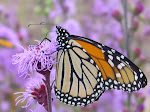News from the Updraft weather blog reported recently that Minnesota is still in a drought. The drought continues even thought we have received snowfall that will eventually melt. Melted snow or melt-water run-off is great for recharging creeks, streams, rivers, ponds, marshes and lakes, but only helps some for melting and soaking into soils. Currently, our soils are frozen. The moisture in the soils are extremely low but enough to freeze and lock additional moisture until April. Currently, there are many evergreen trees and shrubs showing signs of drought that were not seen last fall. White Pine (Pinus strobus) and White Cedar (Thuja occidentalis) and Arborvitae cultivars are showing brown or dried foliage on younger plants.
Meteorologist Paul Huttner reported recently in the Updraft Blog that Minnesota is the fastest warming state in the United States since 1970. This data supports anecdotal observations made by Minnesota gardeners regarding our warmer winters, "gentle soaking rains" are becoming less common, earlier springs, longer autumns, and more common rainfall events (1" to 3" events).
Local Watershed districts, gardeners, permaculture practitioners are responding to our warming climate treads and the increased occurrences of droughts with shift in their approach to landscaping.
Rain barrels and other water harvesting methods are becoming common place, native plants are often used to attract insect pollinators. Natural landscaping techniques to reduce run-off, includes rain gardens, dense hillside plantings, and infiltration planting strips help rain water to soak into soils.
Other observations related to climate change made by gardeners and urban ecologists in Twin Cities area include: increasing gray squirrel populations, steady rabbit populations (year around browsing), and American Robbins are overwintering (often feeding on persistent fruit and berries). Early warm spring weather is not good for gardeners. Early warm weather followed by hard freezes, then followed by warmer weather often damages flowers of trees, shrubs and perennials. In spring 2012, there was substantial damage to apple tree flowers in southern MN. This was followed in the autumn with very low apple crop yields and higher prices at the grocery store. Spring flower damage to woodland ephemeral wildflowers add more stress to these plants which are already diminishing from exotic alien earthworms and white tail deer eating them out of extinction. Great Lakes Worm Watch website explains how invasive exotic aliens (earthworms and common buckthorn) and climate change are causing alarming changes to Minnesota forest ecosystems.
Don Gordon's Growing Fruit in the Upper Midwest is a book essential for anyone interested in growing edible fruit in Minnesota. Our climate in Minnesota has warmed since 1991, when this book was published. Some fruiting trees like peaches and pears may be possible now. However, our spring weather may not cooperate consistently.
The book discusses classic crops like apples, cherries, plums, pear, peaches, raspberries with easy to access useful information. He includes many natural composts and mulches choices. Arrangements for small orchards can be adapted to the even smaller back yard garden.
As a natural landscaper, I find Gordon's suggestions very helpful for people who want to grow fruiting native plants that humans and birds can both feed on. He includes Elderberry (Sambucus), Currants and Gooseberries (Ribes), Serviceberry (Amelanchier), Buffaloberry (Shepherdea) and High Bush Cranberry (Viburnum trilobum).




